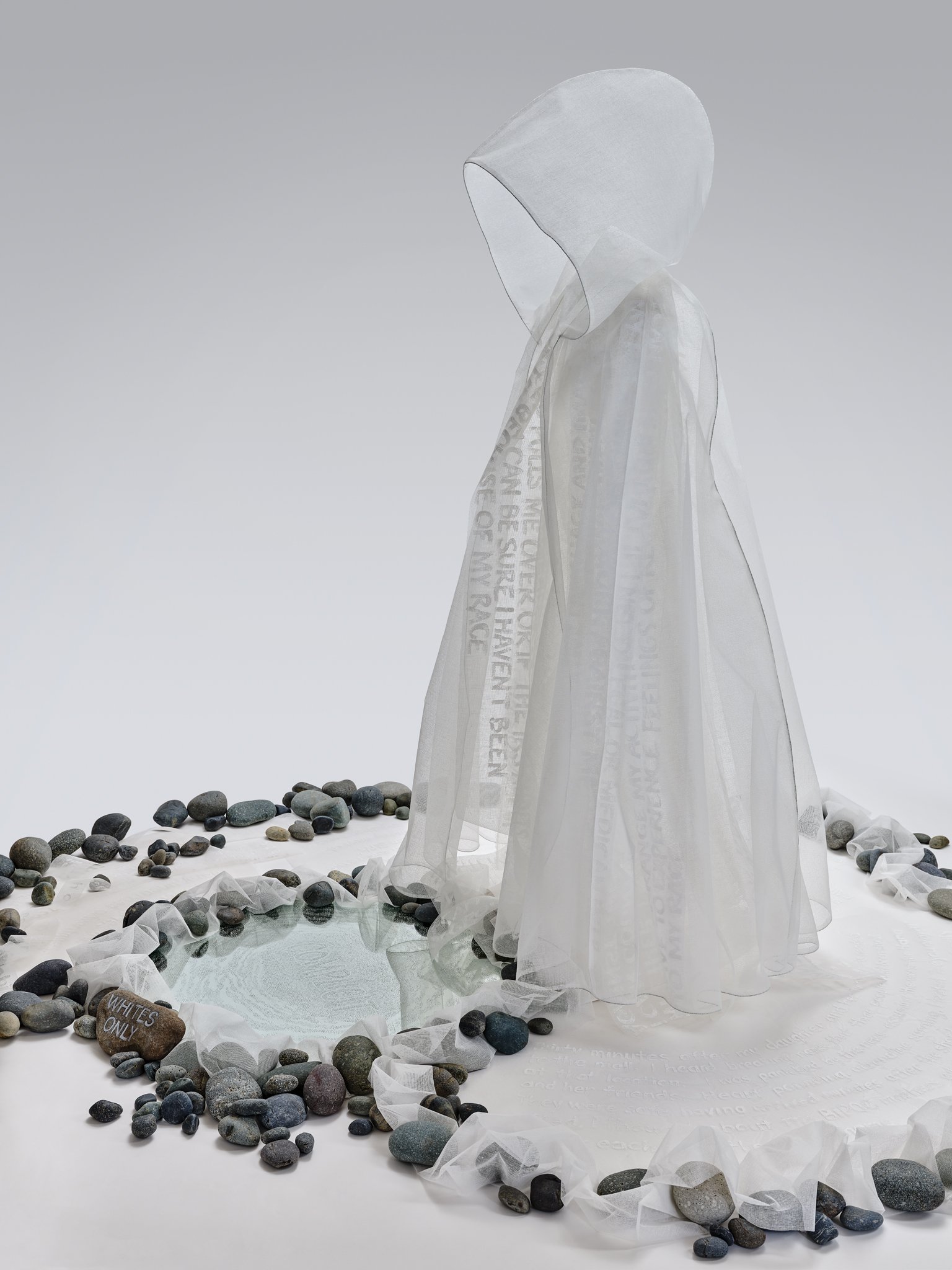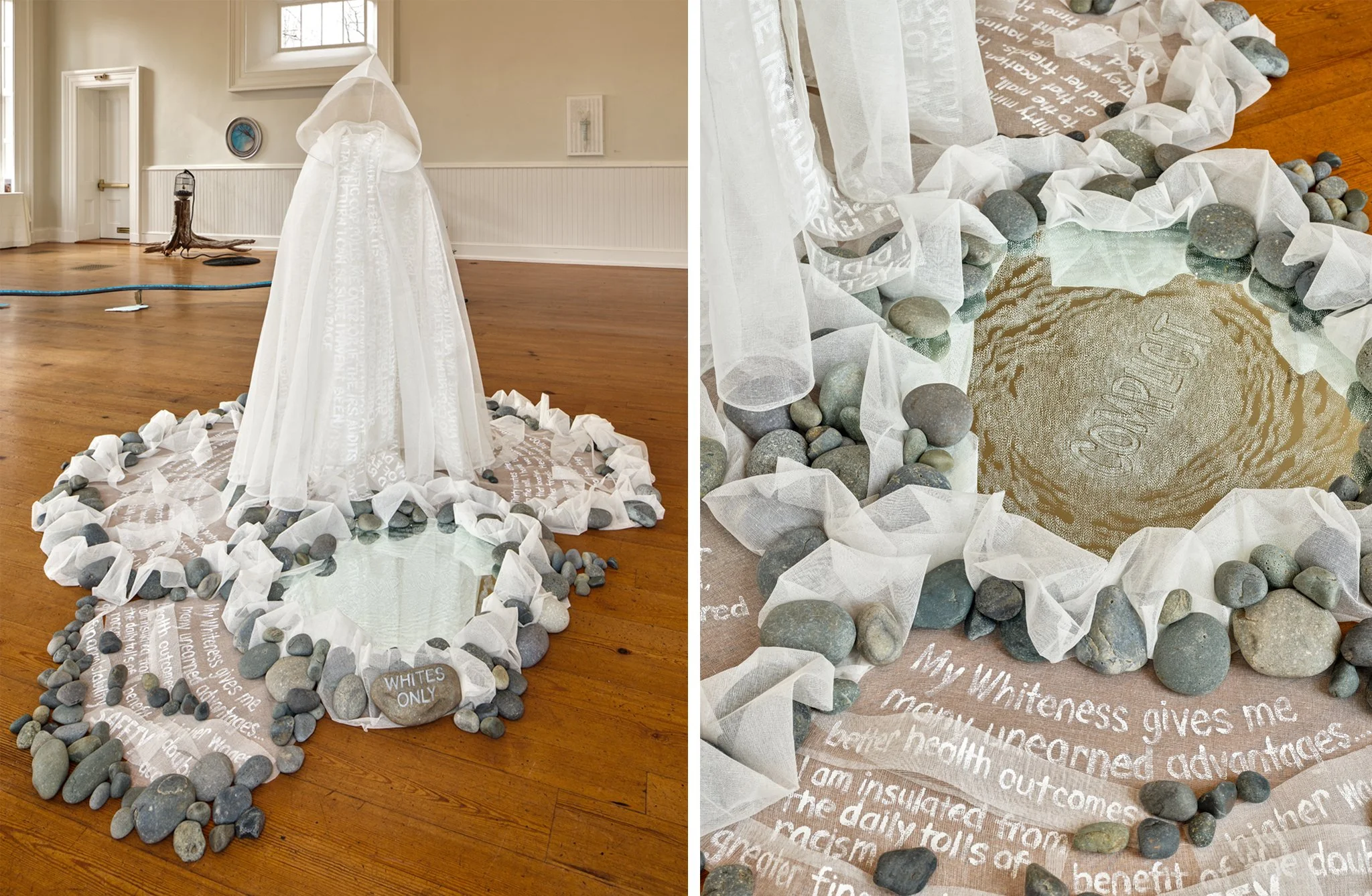Please scroll down for artist statement.
Revealing the Invisible: My Cloak of Privilege
Revealing the Invisible: My Cloak of Privilege
Note: this work is intended for a White audience, as well as for those who pass as White.
In response to the abrupt awakening I had with the onset of the Black Lives Matter protests, I began to investigate my White privilege. I focused on listening and learning by tuning into podcasts (such as Code Switch, Throughline, Seeing White, and Reveal), reading books (such as Between the World and Me; Me and White Supremacy: Combat Racism, Change the World, and Become a Good Ancestor; and Americanah), and attending a workshop (The Inheritance of White Silence). With both White and non-White friends and family members, I immersed myself in deep discussions and reflections about experiences centered on race. I’ve only just begun what will be a life-long journey in understanding my role in racism, how my actions have harmed others, and how to move forward as an anti-racist.
One evening, in the summer of 2020, after the height of the Black Lives Matter protests, I turned to my White daughter’s Black partner of many years and asked how he was doing? And did he feel any more hopeful in light of the protests? I expected David to confirm my feeling that there had been a shift, that this time there would be real momentum in moving toward a more just future. David just paused, looked into his dinner plate, then raised his head to quietly say, “I’ve seen this before.” That moment crystallized my resolve to be more vigilant, less complacent.
Until recently, I never fully understood systemic racism and how my unearned advantages as a White woman contribute to oppression. I have been apathetic about race, which is particularly confounding when you consider the number of people in my family who have had to grapple with racism, whether due to a mixed-race relationship or the color of their skin. This awakening has motivated me to make a life-long commitment to acknowledging both my unearned advantages and my role in the system, while identifying more equitable ways to move forward. I ask myself how can I dial up empathy and minimize apathy? How can I use my privilege to help others, or give away my privilege?
My installation was inspired in part by feminist, anti-racism activist and scholar, Peggy McIntosh, Ph.D. In her 1989 essay “White Privilege: Unpacking the Invisible Knapsack,” she identifies some of the many daily effects of skin privilege in her life. I see my unearned advantages as an invisible cloak that has protected me throughout my life. Many of my unearned advantages, including a large number I share with McIntosh, have been incorporated into this work. The lack of progress since 1989 has inspired me to amplify McIntosh’s groundbreaking work through my own expression.
The cloak form in my installation is comprised of starched cotton and steel wire that has been stitched together with waxed floss. Hand stitching is a meditative process that slows down time and facilitates a reflective state of mind.
Stitching connotes healing.
Nearly all my sculptural works include stitching and/or weaving. Stitching as a means of constructing three-dimensional forms is second nature to me. My mother taught me to sew at an early age and my paternal grandfather was a shoemaker. Stones (actual as well as painted) and intricate mark-making can be found in many of my works.
_____
Hand-painted narratives appearing around the base of the cloak, include the following:
While shopping for a car, my White daughter and her Black partner were told that a red RAV4 was available in their price range. They declined, saying red cars were pulled over more frequently. “I wouldn’t worry so much about a red RAV4,” I interjected. “I’m sure more tickets are issued to red sports cars than SUVs.”
That’s when Hana exclaimed, “Mom, David is Black.” My head immediately dropped. Just a few months after the three of us participated in BLM protests together, I was focused on points and fines, not the safety of Black bodies.
……………..
Thirty minutes after my daughter and her two friends headed to the mall, I heard breaking news that three people had been shot at that location. I was panicked by the news—assuming the worst for Hana and her friends. Herat pounding, adrenaline surging, I texted, “Are you okay?!!” They were safe, having arrived minutes after the shooting. When my panic finally lifted, I thought about the BIPOC mothers who live in fear for their children’s safety each time they leave home.
Note: this work is intended for a White audience, as well as for those who pass as White.
Revealing the Invisible: My Cloak of Privilege at the Athenaeum (In and Between sculpture invitational)

